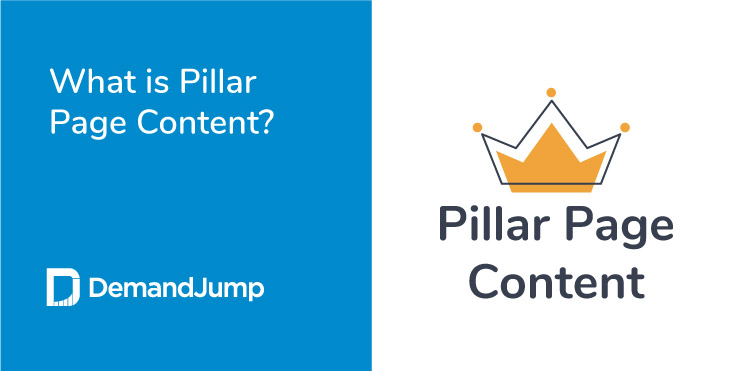What is Pillar Page Content?
March 23, 2022 •Erica Kempf

It’s easy to get focused on the details of search engine optimization (SEO) and struggle to see the bigger picture when it comes to pillar page content in the SEO pillar structure. Let’s start from the 10,000 foot view of what is pillar content strategy as it relates to SEO before we dive into more specific content pillar examples.
What Is a Pillar Post?
In a nutshell, a pillar post describes the main idea of the product or service you provide. What you are trying to do with SEO in general is to show up clearly when someone searches online for your main idea.
How do you do that? The first thing that needs to happen is understanding what words your target audience are using to try to find what you do. These are your keywords. It’s easy to be too close to something to know how someone who has never heard of you might be trying to find you. DemandJump offers the solution by picking keywords for you, based on what people are actually searching for right now.
Answering the question “what is a pillar page” for your specific business is the first step to creating a content marketing strategy that works. As a marketer trying to share exactly what it is your company can do for its customers, this is sometimes surprisingly hard. Using real data from an outside source, like DemandJump, can help you start with the right pillar and the right pillar content to reach your actual potential customers gives you a huge advantage.
Make sure you can use as much of the language your potential customers are searching for as you can. Think first about what problem might be causing people to look for the solution you can provide. They might not know your product even exists, or they may initially think of something different that they search for. If you make your pillar page content more broadly about this pain point for someone, think about what a great resource a pillar page could be for your potential customers. Let’s look at an easy example of how to think about this.

You are a company that sells rain hats and your first thought may be to make “rain hats” the pillar in your content strategy. But think about what problem is driving a potential customer to search the internet for a solution; what is the ‘pain point’ for this person? They want to stay dry in the rain. “Staying dry in the rain” may make a better pillar to start with, because you will show up in a search for more people looking to solve this problem that hadn’t even considered rain hats as a solution.
What is Pillar Content?
Now that you have a nice broad pillar page, writing useful content that addresses the bigger topic your company deals with will be easier. Your pillar page content will deal with this entire issue, and explore many possible options for solving this problem.

Since we’ve gotten the broadest overview, we can jump into more of the specifics of pillar page design. You want your pillar page to provide as much useful information in as easy to understand way as possible about this topic. The more value you can provide to readers, the more they will further explore your resources, look at you as an expert in the field and ultimately, increase your SEO. Here’s a quick list of best practices to make your pillar page as helpful and successful as possible.
- Word Count: Around 3,000 words is long enough to convey all the important information, but not so long no one will read it.
- Broad Topic: It’s important to start with a broad enough topic that you can build more content around it. You will want to add sub- pillars and additional supporting blog posts that link to this pillar page, so don’t start off too specific
- Call to Action (CTA): Try to end the pillar page with a specific way your company addresses the topic and how the reader can engage with you.
- Value Over Sales: Don’t make the whole thing a big sales pitch. Providing useful information is top priority, even if it’s not about you.
- Stick to a Type: There are a few tried and true types of pillars that work well. Try to answer the questions “how to” or “what is,” or provide a guide or resource
- Organize For Skim-Ability: Headings, subheadings, lists and bullet points all help readers get the information they want, fast.
For a specific pillar page template and examples, check out our article What Are Content Pillar Examples.
Ready to Jump Into Your Own Content Strategy?
Content marketing and using the pillar strategy effectively can have a huge impact on how easy you are to find online. But it’s a complicated world out there. Data-driven, actionable information specific to you can make or break your strategy. Create a free account with DemandJump today to start improving your writing and rank higher tomorrow.
Featured Articles
Categories
- Attribution Tracking (13)
- Channel Optimization (11)
- Consumer Insights (68)
- Content Marketing (251)
- Data Science (8)
- Digital Marketing (6)
- Digital Transformation (26)
- Enterprise (10)
- Lead Generation (14)
- Market Intelligence (8)
- Marketing Analytics (39)
- Marketing Attribution (57)
- Marketing Management (153)
- Marketing Operations (86)
- Organic Search (222)
- Paid Search (52)
- Pillar-Based Marketing (63)
- Programmatic Advertising (9)
- SaaS Content (14)
- SaaS Marketing (29)
- Search Marketing (111)
- SEO Keyword Research (28)
- SEO Pillar (18)
- SEO Strategy (46)
- SMB (5)
- Website Content (12)


